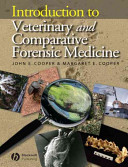Introduction to Veterinary and Comparative Forensic Medicine

Description
Introduction to Veterinary and Comparative Forensic Medicine is a ground-breaking book in an emerging new speciality. It reflects the increasing demand for expert opinion by veterinarians and others in courts of law and elsewhere on such matters as:
• wildlife conservation,
• welfare of, and alleged cruelty to, animals,
• insurance, certification and malpractice
• the identification of live and dead species or their derivatives.
It also discusses and analyses current concern over possible links between domestic violence and abuse of animals. Throughout the book the emphasis is on the need for a systematic and thorough approach to forensic work. A particular feature is practical advice, with protocols on dealing with common problems, together with case studies, various appendices and an extensive bibliography.
A vital reference for members of the veterinary profession, lawyers, enforcement bodies and welfare and conservation organisations. The comparative aspects provide an important source of information for those working in human forensic medicine and the biological sciences.
Autor: Cooper
| Nakladatel | Plot |
|---|---|
| ISBN | 9781405111010 |
| Vydání | 2007 |
| Vazba | pevná |
| Počet stran | 432 |
Reviews
"Reader will find several valuable chapters as well as practical information in appendices...The text is well illustrated with 157 illustrations, including eight pages of color plates."
Veterinary Pathology
About the Author
John and Margaret Cooper are a husband and wife team, from the United Kingdom. John E Cooper trained as a veterinary surgeon and is now a specialist pathologist with particular interests in wildlife and exotic species, tropical diseases and comparative medicine. Margaret E Cooper is a lawyer who trained originally as a British solicitor and has made the study of animal and conservation law her special interest.
The Coopers have travelled widely and lectured together in many countries. They have spent nearly ten years living in Africa, including a period in Rwanda working with the mountain gorillas. They are currently based at the University of the West Indies in Trinidad and Tobago where they continue to combine their medical and legal backgrounds in the promotion of an interdisciplinary approach to veterinary and biological education, wildlife conservation and forensic science.
| Dedication | vii |
| Foreword | viii |
| Authors' Preface | x |
| Part A: Introduction | 1 |
| 1. What is forensic medicine? | 3 |
| 2. The special features of veterinary and comparative forensic medicine | 10 |
| 3. The importance and application of animal law | 42 |
| Part B: Particular Types of Case | 61 |
| 4. Animal welfare | 63 |
| 5. Conservation and wildlife crime | 85 |
| Part C: Methodology | 115 |
| 6. Clinical work | 117 |
| 7. Post-mortem examinations | 168 |
| 8. Laboratory investigations | 225 |
| 9. Site visits and collection of evidence | 241 |
| 10. Collation and analysis of findings and record-keeping | 261 |
| 11. Storage, labelling and presentation of material | 276 |
| 12. Serving as a witness and appearing in court | 285 |
| 13. The future | 304 |
| Appendix A. Submission and report forms - carcasses, tissues and laboratory samples | 315 |
| Appendix B. Useful addresses and sources of information | 331 |
| Appendix C. Glossary of terms | 341 |
| Appendix D. Some case studies, demonstrating approach and techniques | 348 |
| Appendix E. Journals, societies and organisations | 363 |
| Appendix F. Scientific names of species in text | 368 |
| References and Further Reading | 374 |
| Index | 404 |